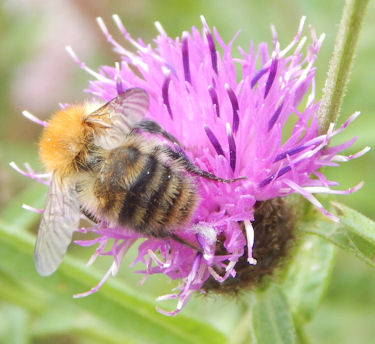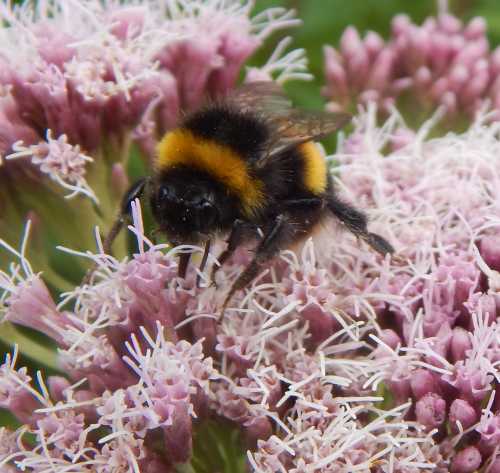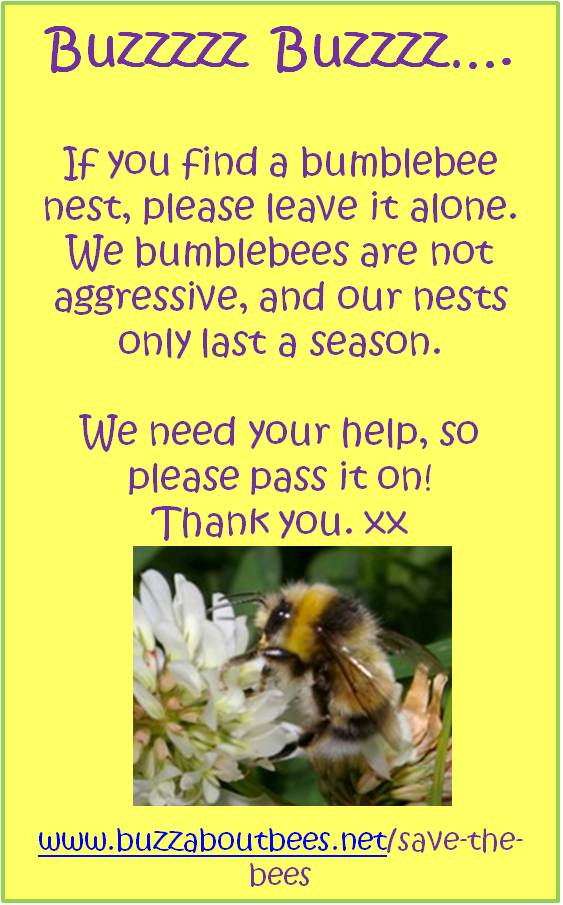Found A Bee?
Updated: 1November 2023
Found a bee and not sure what to do? Is it looking somewhat wet,
bedraggled and in a bit of a sorry state? Should you feed it with sugar or honey?
Usually, it will be a bumble bee that got caught in the rain, but you may also have found a honey bee, or even a solitary bee species.
What can you do?
Please note that if the weather is dry, and the bee is simply motionless
on a flower, leave it alone. The bee is probably resting.
See my guidance: how to tell if a bee is dead or sleeping /resting?
It will probably become
active again in its own time.
Please do not be tempted to interfere in such
cases.
However, if it's raining and getting dark, and you have found a bee that is very wet, bedraggled and can hardly move, and in an exposed position, you could use a ceramic plant pot with a hole in the bottom, and cover the bumble bee to provide a little extra shelter. The bee will be able to escape in the morning through the hole.
It is best to allow the bee to remain outside, where it can get access to nectar and pollen from flowers.
If you have no suitable plant pot available, then you could place the bee in
a shoe box, ensure there are sufficient air holes so that it can breathe. Please note, this is the last resort and your aim must be to release it again as soon as possible - the next day.
Should you feed sugar water to bees?
If you have discovered a bee described in the conditions above, you may offer the bee a solution of sugar water made with clean water and ordinary granulated sugar (do not use artificial or diet sweeteners or demerera sugar).
The ratio of sugar to water should be about 1:2 (i.e. one spoon of sugar to two spoons of water). Please do not offer a higher concentration of sugar than this.
Do not
use honey, because honey may contain traces of viruses that may be
passed on to the wild bee
The best way to offer the sugar water is to sprinkle drops of water on to a clean, solid work surface near to the bee, or dip a
flower head into it - this could be a dandelion head, for instance. One
gentleman wrote to me to say that he uses moss.
Update: I have more in depth information on feeding sugar to bees.
It's cold outside. Will the bee survive?
Bumble bees can survive in fairly cool temperatures up to around -7.1°C1. (See - Can Bumble Bees Survive Cool Temperatures?).
Damaged wings or limbs
If you encounter a bee with damaged wings or limbs, leave it alone and allow nature to take its course.
Bees do become more ragged with age or perhaps after attack, but given the chance, they will continue to be as busy as possible.
I recall sitting on a beach one day when a Bombus pascuorum (Common Carder bee) landed on my shorts. It clearly had one leg missing, yet flew away moments after.
 Bombus pascuorum - common carder bumble bee on knapweed.
Bombus pascuorum - common carder bumble bee on knapweed.Reader experience
I received a wonderful email from a reader, Cheryl Colpman. It proves that you really can make a difference, and the lady has kindly agreed to allow me to add her experience to this website. I hope it inspires others:
"Thank you for your lovely website and easy to read help on looking after bedraggled bees.
I saved 3 bees on Friday, one of whom spent the night in our house in a shallow un-lidded, lined wooden box, placed inside a large organza bag, with the chive flower he'd been found on. I dipped another chive flower in sugar solution as that seemed easier for him to take than from the shallow lid I also gave him. I took him outside early the next morning and gently turned the organza bag so he was free and 15 minutes later I watched him take off and fly away. Lovely!
Thank you so much for your guidance. Blessings to you. (shared your page on my holistic Facebook page)".
- Cheryl Colpman
Is it okay to capture bees to feed them?
If you want to feed the bees, the best way is to provide
bee plants
that are rich in nectar and pollen. Avoid insecticides.
Please do not capture a bee, purely in order to see if it will allow you to feed it. (I hear stories of this – it isn’t helping the bees, it is simply preventing them feeding in a natural way on the things they need, which include the different pollens and nectars from a variety of flowers).
May I capture and keep this bumble bee in my bee house?
Most people who buy bumble bee houses wish to help the bees.
However,
I have heard of bumble bee houses for sale,
with instructions to capture queens, and feed them sugar water for a
while in order to persuade them to make a nest in the bee house.
If
you have purchased such a bumble bee house, please
ignore suggestions to capture queen bumble bees. For a start, you may capture a species that prefers different
nesting conditions!
There is also a risk the bumble bee queen has already begun to rear a colony.
By all means, purchase a bee house, place some hamster bedding in it,
and put it in a sheltered area in the shade, away from ants and animals,
then let nature take its course.
My advice is this: create the conditions to encourage bees into your garden – by creating a bee garden. This is achieved mainly with plants for bees.
There is a bee trapped in a spider web, how can I get it out?
See my advice about bees trapped in spider web.
Ever wondered......
Do bumble bees make honey?

References
1. Owen EL, Bale JS, Hayward SAL (2013) Can winter-active bumblebees survive the cold? Assessing the cold tolerance of Bombus terrestris audax and the effects of pollen feeding. PLoS ONE 8(11): e80061
If you found this page helpful or interesting, I'd really be grateful if you would share it with others - if not this page, perhaps another, such as Gardening For Bees.
Thank you so much :) .
